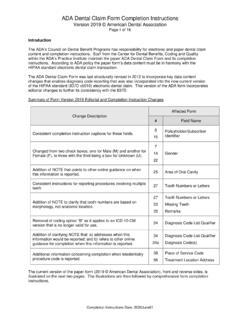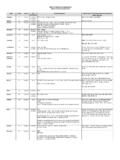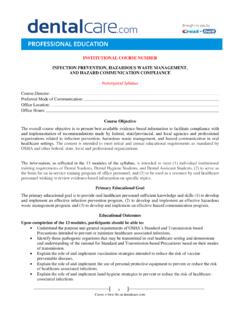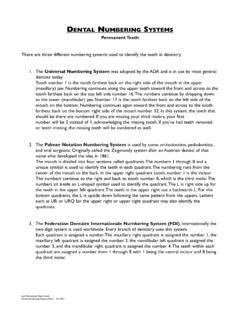Transcription of Guidelines for Use of Sedation and Anesthesia by Dentists
1 Page 1 of 12 Guidelines for the Use of Sedation and General Anesthesia by Dentists Adopted by the ADA House of Delegates, October 2016 I. Introduction The administration of local Anesthesia , Sedation and general Anesthesia is an integral part of dental practice. The american dental association is committed to the safe and effective use of these modalities by appropriately educated and trained Dentists . The purpose of these Guidelines is to assist Dentists in the delivery of safe and effective Sedation and Anesthesia . Dentists must comply with their state laws, rules and/or regulations when providing Sedation and Anesthesia and will only be subject to Section III.
2 Educational Requirements as required by those state laws, rules and/or regulations. Level of Sedation is entirely independent of the route of administration. Moderate and deep Sedation or general Anesthesia may be achieved via any route of administration and thus an appropriately consistent level of training must be established. For children, the american dental association supports the use of the american Academy of Pediatrics/ american Academy of Pediatric Dentistry Guidelines for Monitoring and Management of Pediatric Patients During and After Sedation for Diagnostic and Therapeutic Procedures. II. Definitions Methods of Anxiety and Pain Control minimal Sedation (previously known as anxiolysis) - a minimally depressed level of consciousness, produced by a pharmacological method, that retains the patient's ability to independently and continuously maintain an airway and respond normally to tactile stimulation and verbal command.
3 Although cognitive function and coordination may be modestly impaired, ventilatory and cardiovascular functions are Patients whose only response is reflex withdrawal from repeated painful stimuli would not be considered to be in a state of minimal Sedation . The following definitions apply to administration of minimal Sedation : maximum recommended dose (MRD) - maximum FDA-recommended dose of a drug, as printed in FDA-approved labeling for unmonitored home use. dosing for minimal Sedation via the enteral route minimal Sedation may be achieved by the administration of a drug, either singly or in divided doses, by the enteral route to achieve the desired clinical effect, not to exceed the maximum recommended dose (MRD).
4 The administration of enteral drugs exceeding the maximum recommended dose during a single appointment is considered to be moderate Sedation and the moderate Sedation Guidelines apply. Nitrous oxide/oxygen when used in combination with sedative agent(s) may produce minimal, moderate, deep Sedation or general Anesthesia . Page 2 of 12 If more than one enteral drug is administered to achieve the desired Sedation effect, with or without the concomitant use of nitrous oxide, the Guidelines for moderate Sedation must apply. Note: In accord with this particular definition, the drug(s) and/or techniques used should carry a margin of safety wide enough never to render unintended loss of consciousness.
5 The use of the MRD to guide dosing for minimal Sedation is intended to create this margin of safety. moderate Sedation - a drug-induced depression of consciousness during which patients respond purposefully to verbal commands, either alone or accompanied by light tactile stimulation. No interventions are required to maintain a patent airway, and spontaneous ventilation is adequate. Cardiovascular function is usually Note: In accord with this particular definition, the drugs and/or techniques used should carry a margin of safety wide enough to render unintended loss of consciousness unlikely. Repeated dosing of an agent before the effects of previous dosing can be fully appreciated may result in a greater alteration of the state of consciousness than is the intent of the dentist.
6 Further, a patient whose only response is reflex withdrawal from a painful stimulus is not considered to be in a state of moderate Sedation . The following definition applies to the administration of moderate or greater Sedation : titration - administration of incremental doses of an intravenous or inhalation drug until a desired effect is reached. Knowledge of each drug s time of onset, peak response and duration of action is essential to avoid over Sedation . Although the concept of titration of a drug to effect is critical for patient safety, when the intent is moderate Sedation one must know whether the previous dose has taken full effect before administering an additional drug increment.
7 Deep Sedation - a drug-induced depression of consciousness during which patients cannot be easily aroused but respond purposefully following repeated or painful stimulation. The ability to independently maintain ventilatory function may be impaired. Patients may require assistance in maintaining a patent airway, and spontaneous ventilation may be inadequate. Cardiovascular function is usually general Anesthesia - a drug-induced loss of consciousness during which patients are not arousable, even by painful stimulation. The ability to independently maintain ventilatory function is often impaired. Patients often require assistance in maintaining a patent airway, and positive pressure ventilation may be required because of depressed spontaneous ventilation or drug-induced depression of neuromuscular function.
8 Cardiovascular function may be impaired. Because Sedation and general Anesthesia are a continuum, it is not always possible to predict how an individual patient will respond. Hence, practitioners intending to produce a given level of Sedation should be able to diagnose and manage the physiologic consequences (rescue) for patients whose level of Sedation becomes deeper than initially For all levels of Sedation , the qualified dentist must have the training, skills, drugs and equipment to identify and manage such an occurrence until either assistance arrives (emergency medical service) or the patient returns to the intended level of Sedation without airway or cardiovascular complications.
9 Routes of Administration enteral - any technique of administration in which the agent is absorbed through the gastrointestinal (GI) tract or oral mucosa [ , oral, rectal, sublingual]. parenteral - a technique of administration in which the drug bypasses the gastrointestinal (GI) tract [ , intramuscular (IM), intravenous (IV), intranasal (IN), submucosal (SM), subcutaneous (SC), intraosseous (IO)]. Page 3 of 12 transdermal - a technique of administration in which the drug is administered by patch or iontophoresis through skin. transmucosal - a technique of administration in which the drug is administered across mucosa such as intranasal, sublingual, or rectal.
10 Inhalation - a technique of administration in which a gaseous or volatile agent is introduced into the lungs and whose primary effect is due to absorption through the gas/blood interface. Terms analgesia the diminution or elimination of pain. local Anesthesia - the elimination of sensation, especially pain, in one part of the body by the topical application or regional injection of a drug. Note: Although the use of local anesthetics is the foundation of pain control in dentistry and has a long record of safety, Dentists must be aware of the maximum, safe dosage limits for each patient. Large doses of local anesthetics in themselves may result in central nervous system depression, especially in combination with sedative agents.







